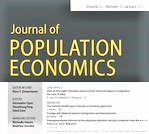A new paper published in the Journal of Population Economics investigates for the Italian case the effects of working from home on income inequality at the time of COVID-19 and the implications for the future.
Read more in:
Working from home and income inequality: risks of a ‘new normal’ with COVID-19
Luca Bonacini, Giovanni Gallo & Sergio Scicchitano
Journal of Population Economics (2020), published ONLINE FIRST. PDF free accessible.
Based on GLO Discussion Paper No. 541, 2020
GLO Fellows Giovanni Gallo & Sergio Scicchitano and GLO Affiliate Luca Bonacini

Giovanni Gallo 
Sergio Scicchitano 
Luca Bonacini
Author Abstract: In the current context of the COVID-19 pandemic, working from home (WFH) became of great importance for a large share of employees since it represents the only option to both continue working and minimise the risk of virus exposure. Uncertainty about the duration of the pandemic and future contagion waves even led companies to view WFH as a ‘new normal’ way of working. Based on influence function regression methods, this paper explores the potential consequences in the labour income distribution related to a long-lasting increase in WFH feasibility among Italian employees. Results show that a positive shift in WFH feasibility would be associated with an increase in average labour income, but this potential benefit would not be equally distributed among employees. Specifically, an increase in the opportunity to WFH would favour male, older, high-educated, and high-paid employees. However, this ‘forced innovation’ would benefit more employees living in provinces have been more affected by the novel coronavirus. WFH thus risks exacerbating pre-existing inequalities in the labour market, especially if it will not be adequately regulated. As a consequence, this study suggests that policies aimed at alleviating inequality, like income support measures (in the short run) and human capital interventions (in the long run), should play a more important compensating role in the future.
More from the GLO Coronavirus Cluster
Access to the newly published complete Volume 33, Issue 4, October 2020.
LEAD ARTICLE OF ISSUE 4:
Yun Qiu, Xi Chen & Wei Shi, Impacts of social and economic factors on the transmission of coronavirus disease 2019 (COVID-19) in China
Journal of Population Economics 33, 1127–1172 (2020). OPEN ACCESS
OTHER COVID-19 ARTICLES JUST PUBLISHED ONLINE FIRST.
Fabio Milani: COVID-19 outbreak, social response, and early economic effects: A global VAR analysis of cross-country interdependencies. Journal of Population Economics, (2020). https://doi.org/10.1007/s00148-020-00792-4.
PDF free accessible.
Luca Bonacini, Giovanni Gallo & Fabrizio Patriarca: Identifying policy challenges of COVID-19 in hardly reliable data and judging the success of lockdown measures. Journal of Population Economics, (2020). https://doi.org/10.1007/s00148-020-00799-x PDF free accessible.

Ends;
